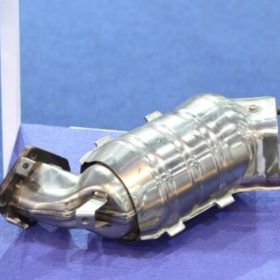Platinum, rhodium, palladium and even gold can act as a perfect catalyst in the catalytic converter. Without them, the process would have been impossible.The entire filling of the catalytic converter looks like a layer of precious metals deposited on ceramic honeycomb. And the catalytic converter is not only a unit, but also a housing, and lambda sensors, and a heat insulator casing.It is the ceramic block that is the catalytic converter of the reaction, and not the entire item assembly that is “dusting” into the cylinders, so they usually talk about removing the catalytic converter, sometimes replacing it with other parts.
The first catalytic converter was install in 1975. But there were no big problems from them then, and until recently no one could have thought that the catalytic converter could cause scuffing and oil scrapes. The catalytic converter was located far from the cylinder block, in the exhaust system somewhere under the bottom of the car. Yes, the catalytic converter can die there too: clog up and fall apart. And this is very important for all car owners, not only unique vehicle fans.
The suffering is insignificant: the car pulls worse, but the motor remains intact. The error of the lambda sensors that do not understand what is happening with the amount of oxygen can also be annoying. The solution to the problem is elementary, a catalytic converter is change.
The situation become much worse when a catalytic converter was place close to the unit. In case of destruction of the base, ceramic dust begin to enter the cylinders. There are still people who are convince that dust from the exhaust can not get into the intake. At the time of valve overlap, when the piston approaches the top dead center, when the intake valve is already open, and the exhaust valve is not closed yet.
When the catalyst needs to be replaced
Engineers under the guarantee are partly to blame for the disbelief in the possibility of ceramic dust entering cylinders. They at one time convinced the victims of a catalytic converter that the destruction of this wonderful element could not happen. Although, at the same time, the guarantee for the catalytic converter was only a thousand kilometers, and it was proposed to change the killed engine at your own expense. Ceramic dust can get into the cylinders.
Pay attention to this essential vehicle part, because there is nothing to do when the catalytic converter has to be changed. Cleaning the catalytic converter will help to prolong the life of your car and motor itself without much time and efforts.
A ceramic catalytic converter will eventually fail on any vehicle. But the danger is primarily those that stand on the exhaust manifold at a distance of 15-20 cm from the cylinder head. In addition, there are motors, where the catalytic converter was installed in the exhaust manifold, built directly into the cylinder head. Over time, there are more and more motors with collectors and the problem is more and more widespread.
Catalytic converter failure: causes and consequences
The catalytic converter turns out to be really clogged to a brick state. It is removed, ideally with a firmware correction. And the car starts to go. And after a while, its owner returns with a complaint about the oil consumption that has appeared. In most cases, the reason is very simple: the ceramic chips have already got into the engine and have done their dirty work.
The driver of the car must control the catalytic converter by himself if it is possible, as the engine power depends on it. A dirty device will result in increased fuel consumption and reduced vehicle dynamics. At first symptoms, you need to check the catalytic converter, which can be done even in the garage or in a car service. Importance of this device for a car is essential not only for nature, but for laws of different countries. Strict rules request many vehicle control services. Get everything is done in time and without drastic methods to avoid problems in future.
The engine has to respond better to the gas pedal. And the oil consumption of a scuffed engine is very dependent on the crankshaft speed. So there is a feeling that the “oil grub” appeared just after the removal of the catalytic converter. Although almost always it was in this case before: the piston was already ruine by dust.
Catalytic converter removing
remove catalytic converter after it is already severely damage. It is worth checking cylinders with an endoscope. If there are bullies, active driving will only increase the already existing oil consumption. In addition, the present oil burner itself is capable of killing a normal catalytic converter. The oil mist with additives will clog it quickly enough due to an increase in pressure in the crankcase. In this case, the increase in oil consumption with the removal of the catalytic converter is very, very indirect. But there is a situation when the oil burner starts precisely because of the removal of the catalytic converter.


